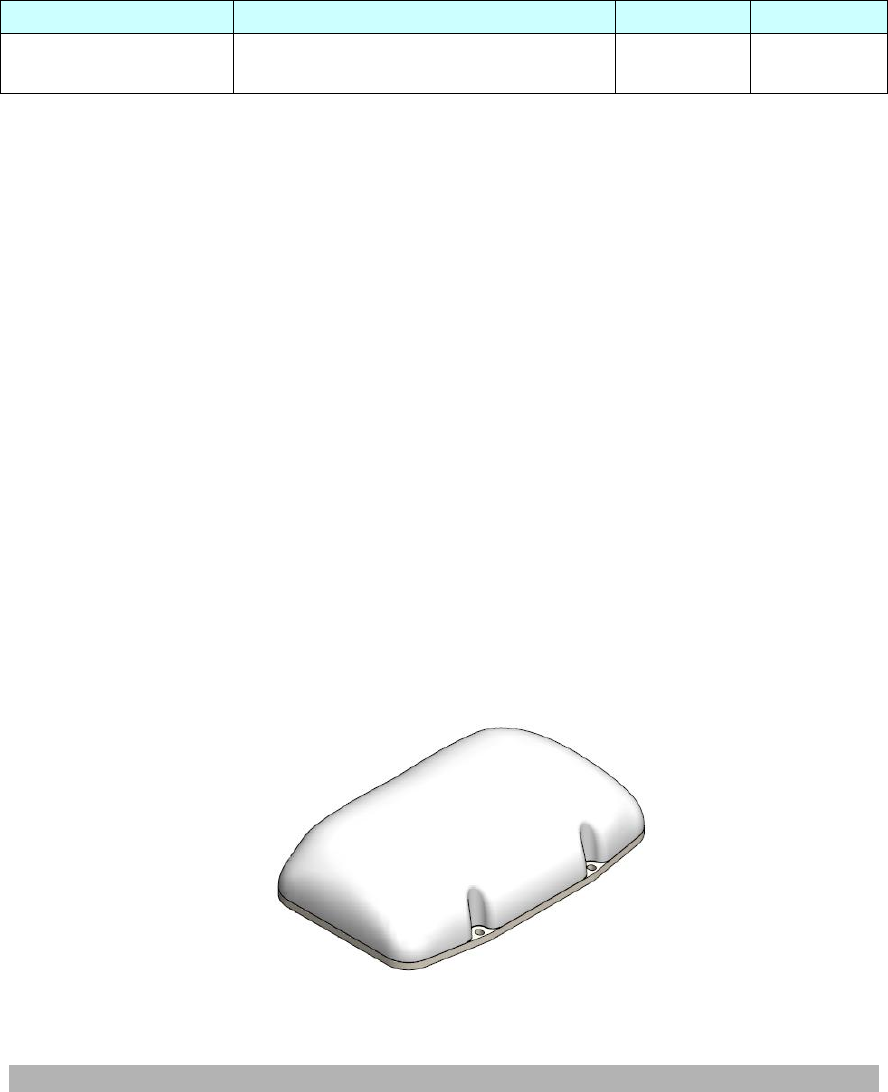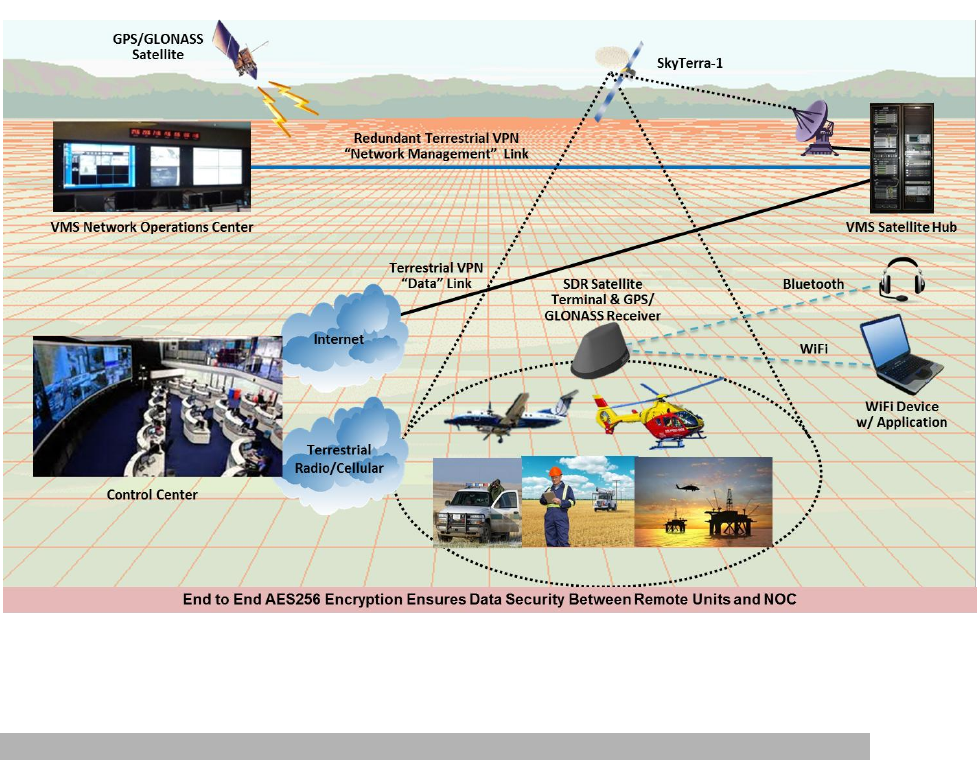ViaSat AT2220 Fixed L-Band satellite modem with WLAN and Bluetooth User Manual
ViaSat, Inc. Fixed L-Band satellite modem with WLAN and Bluetooth
ViaSat >
Contents
- 1. User Manual
- 2. User Manual I
- 3. User Manual II
User Manual

ViaSat Proprietary
PR000190 Rev 004
Product Description
for
AT2220
Document No.: 1194238, Rev. 001
18 June 2014
Prepared by:
ViaSat Inc.
6155 El Camino Real
Carlsbad, California 92009
COPYRIGHT NOTICE
©Copyright 2014 ViaSat, Inc. All rights reserved.
Printed in the United States of America
TRADEMARK NOTICE
ViaSat and the ViaSat logo are registered trademarks of ViaSat, Inc. in the U.S. and/or other
countries. Other product names included in this document are trademarks of their respective
owners.
DOCUMENTATION NOTICE
The information, specifications, and features contained in this document are subject to change
without notice and should not be construed as a commitment by ViaSat, Inc.
ViaSat, Inc. assumes no responsibility for any errors that may appear in this document nor does it make
expressed or implied warranty of any kind with regard to this material, including, but not limited to, the implied
warranties of merchantability and fitness for a particular purpose. ViaSat, Inc. shall not be liable for incidental or
consequential damages in conjunction with, or arising out of the furnishing, performance, or use of this document and
the program material it describes. ViaSat Proprietary
THESE DRAWINGS, LISTS OR SPECIFICATIONS ARE THE CONFIDENTIAL INFORMATION AND/OR TRADE SECRETS
OF VIASAT, INC., AND ISSUED IN STRICT CONFIDENCE. EXCEPT AS AUTHORIZED BY VIASAT IN WRITING, THESE
DRAWINGS, LISTS OR SPECIFICATIONS SHALL NOT BE REPRODUCED, RETRANSMITTED, USED FOR THE DESIGN,
MANUFACTURE OR SALE OF EQUIPMENT OR USED FOR ANY OTHER PURPOSE OTHER THAN EVALUATION.

ViaSat Proprietary
Document No.: 1194238, Rev 001
18 June 2014
i
ViaSat Proprietary PR000190 Rev. 004
Revision Record
Revision
Rationale
Release Date
001
Initial Release
18 June 2014
WARNING: This device emits radio frequency (RF) energy when in transmit mode. In order to
comply with FCC RF Exposure limits, the unit must be installed in such a way as to ensure that a
minimum separation distance of 18.5 inches (47cm) is maintained between the antenna and
any nearby persons.

ViaSat Proprietary
Document No.: 1194238, Rev 001
18 June 2014
ii
ViaSat Proprietary PR000190 Rev. 004
Table of Contents
1 SCOPE .................................................................................................................................................. 1
2 REFERENCE DOCUMENTS ............................................................................................................ 1
3 TERMINAL OVERVIEW & OPERATIONAL CONCEPTERROR! BOOKMARK NOT DEFINED.
4 SPECIFICATIONS............................................................. ERROR! BOOKMARK NOT DEFINED.
4.1 General Specifications ...................................................................................................................... 3
4.2 Interface ............................................................................................................................................ 4
4.3 Mechanical ........................................................................................................................................ 4
4.4 Environmental Conditions................................................................................................................. 4
4.5 Software Design Assurance Level .................................................................................................... 5
4.6 Regulatory Approvals ....................................................................................................................... 5
4.7 Features and Capabilities .................................................................................................................. 6
4.8 Terminal Management ...................................................................................................................... 6
5 PRODUCT PACKAGE ....................................................................................................................... 7
A Appendix - Acronyms ......................................................................................................................... 9

ViaSat Proprietary
Document No.: 1194238, Rev 001
18 June 2014
iii
ViaSat Proprietary PR000190 Rev. 004
List of Figures
Figure 1: AT2220 Mobile Terminal ............................................................................................................... 1
Figure 2: End-users access satellite service via Terminal operating hub-spoke with Hub ............................. 2
List of Tables
Table 1: Reference Documents ....................................................................................................................... 1
Table 2: Environmental Conditions ................................................................................................................ 4

ViaSat Proprietary
Document No.: 1194238, Rev 001
18 June 2014
1
ViaSat Proprietary PR000190 Rev. 004
1 SCOPE
This product definition document defines essential characteristics and functionality of the
ViaSat AT2220 Terminal.
2 REFERENCE DOCUMENTS
Table 1: Reference Documents
Document Number
Document Title
Revision
Date
1178156
ViaSat Mobile Satellite Services
Overview and Description
002
4/12/2013
3 TERMINAL OVERVIEW AND OPERATIONAL CONCEPT
The ViaSat AT2220 Terminal enables reliable and instant IP-based communications via
satellite for rotor and fixed-wing aircraft.
Powered by ViaSat L-band Managed Service (VMS), this satcom terminal’s two-way
networking capability enables both real-time monitoring of position location information
using built in GPS receiver, and data and voice communications. FIPS-certified data link
layer encryption is employed to ensure the integrity of user data is protected. The
terminal features easy-to-use interfaces and provides flexibility to configure to nearly any
sensor system or IP data application. Examples of operational scenarios that the AT2220
Terminal supports range from fleet management, emergency first responders, homeland
security forces, disaster aid workers, corresponders, mobile workforce management and
tracking of high-valued assets. This is all within an integrated single assembly package
that is optimized for airborne data transmission. A single cable provides DC power and
Ethernet for wired connections to an IP device, eliminating the need of RF cable typically
required for connection between modem and antenna. The transceiver also supports Wi-
Fi and Bluetooth for wireless connections to multiple tablets or smartphones. The
AT2220 Terminal is powered by ViaSat advanced waveform that allows for a low
latency and highest capacity of users to operate on a single L-band channel. A rendering
of the AT2220 Terminal is shown in the Figure 1. Terminal size, weight and
characteristics are provided in Section Error! Reference source not found..
Figure 1: AT2220 Mobile Terminal

ViaSat Proprietary
Document No.: 1194238, Rev 001
18 June 2014
2
ViaSat Proprietary PR000190 Rev. 004
The AT2220 terminal is designed to be flexibile in application, incorporating features and
functions that are important in M2M mobile applications. In particular, the terminal is
tailored to provide the followings:
Ruggedized design to handle harsh environments
Integral antenna & modem in a single low profile unit
Ethernet, Wi-Fi, Bluethooth interface options
Two-way send/receive connectivity
Low latency for instant message transfer and real time monitoring
Push To Talk (PTT) voice
Low service cost with a bandwidth efficient waveform
Optional dual receiver capability (can receive two forward links simultaneously)
Figure 2 illustrates the concept of operation. End-users operating on mobile or fixed
platforms access satellite service through the AT2220 terminals and assigned satellite
channel. A ViaSat hub accesses a satellite provider’s RF feeder link to provide satellite
service to the end-users and connectivity to the AT2220 transceivers in a hub-spoke
topology. A terrestrial VPN link connects the ViaSat Network Operation Center (NOC)
to the hub for network management and control through a commercial router.
Figure 2: End-users access satellite service via Terminal operating hub-spoke with Hub

ViaSat Proprietary
Document No.: 1194238, Rev 001
18 June 2014
3
ViaSat Proprietary PR000190 Rev. 004
4 SPECIFICATIONS
The following subsections list specifications for the AT2220 terminal.
4.1 General Specifications
Antenna Polarization:
RHCP & LHCP, software configurable
Frequency band:
TX: 1626.5 – 1675.0 MHz
Rx: 1518.0 – 1559.0 MHz
Forward Link waveform:
BPSK, QPSK, 8-PSK and 16-APSK
Spread and unspread modes supported
FEC – Low Density Parity Check (LDPC)
Return: CRMA, GMSK code rate 1/3 and 1/5
Return Link waveform:
ViaSat patented CRMA ALOHA burst multiple access, packets sent
immediately upon arrival
GMSK spreading modulation
Direct Sequence Spread Spectrum with spreading factor 4<=K<=22
FEC – Turbo code, r=1/3 and r=1/5
Transmit EIRP:
Up to +8 dBW, configurable in 0.1 dB steps
Receive G/T:
Up to -21.0 dB/K
Data Rate:
Forward: Up to 1 Mbps *
Return: 1 kbps to 20 kbps* burst rate, multiple terminals can transmit
simultaneously on the same channel, increasing system throughput
Voice codec:
MELPe, 600/1200/2400 bps
Transmission Security
Link encryption: AES-256
Cryptographic certification: Certifiable to FIPS-140-2 Level 2
GNSS
GPS + GLONASS
Input Power
DC: 10-32 V
60 Watts max
(*) = Achievable data rate is dependent on satellite channel parameters/link budget

ViaSat Proprietary
Document No.: 1194238, Rev 001
18 June 2014
4
ViaSat Proprietary PR000190 Rev. 004
4.2 Interface
The AT2220 terminal provides the following external interfaces:
Power 10-32 VDC, via multi-pin connector with short circuit protection
Ethernet via multi-pin connector
Bluetooth 4.0
Wi-Fi IEEE 802.11 B/G, 2.4 GHz
GNSS L1 frequency
4.3 Mechanical
Size: 8.85 in. x 6.77 in. x 3.14 in.
Weight: 2.0 lbs.
Finish: Plastic radome with painted metal housing, both suitable for continuous
outdoor exposure
4.4 Environmental Conditions
Table 2: Environmental Conditions
Environmental and EMI Tests
DO-160G
Section
Test Category
Temperature and Altitude:
4
Low Temp
4.5.2
F2
High Temp
4.5.3 & 4.5.4
F2
In-Flight Loss of Cooling
4.5.5
X, no test performed
Altitude
4.6.1
F2
Decompression
4.6.2
X, no test performed
Overpressure
4.6.3
X, no test performed
Temperature Variation
5
A
Humidity
6
C
Operational Shocks & Crash Safety
7
A
Vibration
8
Category S, Curves L, M, and Y
Category U2, Curves F and F1
Explosive Atmosphere
9
E
Waterproofness
10
S
Fluids Susceptibility
11
F
Sand and Dust
12
S
Fungus Resistance
13
F
Salt Spray
14
T
Magnetic Effects
15
Z

ViaSat Proprietary
Document No.: 1194238, Rev 001
18 June 2014
5
ViaSat Proprietary PR000190 Rev. 004
Environmental and EMI Tests
DO-160G
Section
Test Category
Power Input
Category B (14V & 28V)
Voltage Spike
17
A
Audio Frequency Conducted
Susceptibility
18
B
Induced Signal Susceptibility
19
AC (interference-free operation is desirable)
Radio Frequency Susceptibility
20
Category T (conducted) Category T
(radiated)
Emission of Radio Frequency Energy
21
H (in direct view of receiver antenna)
Lightning Induced Transient
Susceptibility
22
B4K4X
Lightning Direct Effects
23
1A2A
Icing
24
C
Electrostatic Discharge
25
A
Fire and Flammability
26
X, no test performed
4.5 Software Design Assurance Level
The embedded software of the AT2220 is in compliance with the applicable
airworthiness regulations for the software aspects of airborne systems per DO-178C
Level E.
4.6 Regulatory Approvals
The AT2220 terminal is designed to satisfy all necessary requirements to obtain
approvals for the following:
CE Per R&TTE Directive 1999/5/EC, Low Voltage Directive 2006/95/EC
FCC Title 47 Section 15, Title 47 Section 25
RCM AS/NZS CISP22
Safety IEC/EN/AS/NZS 60950-1, IEC/EN/AS/NZS 60950-22
RoHS Per European Union Council Directive 2011/65/EU
REACH Per European Union Council Directive 1907/2006/EC
WEEE Per European Union Council Directive 2012/19/EU

ViaSat Proprietary
Document No.: 1194238, Rev 001
18 June 2014
6
ViaSat Proprietary PR000190 Rev. 004
4.7 Features and Capabilities
The AT2220 terminal supports the following features and capabilities
IPv4 (IPv6 upgradable):
Full IPv4 support including unicast, multicast and broadcast capabilities,
supporting IP based user applications
Low latency which is ideal for data reporting, remote device control, voice
communications and messaging
Secure communication
The VMS network provides enhanced end to end data security
Over-The-Air (OTA) SW Upgrades
Terminal software upgrades performed over the air
Push to Talk (PTT) secure netted voice:
One talk, Multiple listen. PTT capabilities include customized private call groups
with other VMS terminals and Internet based users
GPS NMEA Server
NMEA stream from the embedded GPS receiver is accessible to IP based
applications providing easy access to GPS data for user applications
Automatic Vehicle Location (AVL) Server
An AVL server is embedded within the terminal providing full AVL services for
aircraft installations
4.8 Terminal Management
The AT2220 terminal supports control, configuration and status via both the attached
host platform and OTA.
Local management:
Using an embedded HTTP server or a 3GPP based AT command set. Both HTTP
and 3GPP interfaces are available.
Remote management:
Using the VMS network terminal command and control interface
The AT2220 terminal management interfaces support the following features:
Terminal health and status monitoring, including connection state, forward/return
signal levels
Terminal/end user data usage monitoring: bytes sent/received, session duration
Terminal location reporting
Terminal diagnostic fault reporting and log retrieval
Terminal IP network configuration
Historical terminal status/statistics retrieval
Initiation and monitoring of OTA Software Download activities to terminals for
software/firmware upgrades

ViaSat Proprietary
Document No.: 1194238, Rev 001
18 June 2014
7
ViaSat Proprietary PR000190 Rev. 004
Reboot, re-login, and channel switch
4.9 FCC Regulatory Information
Compliance Statement (Part 15.19)
The enclosed hardware device complies with Part 15 of the FCC Rules. Operation is
subject to the following two conditions: (1) This device may not cause harmful
interference, and (2) This device must accept any interference received including
interference that may cause undesired operation.
Warning (Part 15.21)
Changes or modifications not expressly approved by ViaSat could void the user’s
authority to operate the equipment. Manufacturer is not responsible for any radio or TV
interference caused by unauthorized modifications to this equipment.
Compliance Statement (Part 15.105(b))
This equipment has been tested and found to comply with the limits for a Class A digital
device, pursuant to Part 15 of the FCC Rules. These limits are designed to provide
reasonable protection against harmful interference in an industrial installation. This
equipment generates, uses and can radiate radio frequency energy and, if not installed and
used in accordance with the instructions, may cause harmful interference to radio
communications. However, there is no guarantee that interference will not occur in a
particular installation. If this equipment does cause harmful interference to radio or
television reception, which can be determined by turning the equipment off and on, the
user is encouraged to try to correct the interference by one or more of the following
measures:
• Reorient or relocate the receiving antenna
• Increase the separation between the equipment and receiver
• Connect the equipment into an outlet on a circuit different from that to which the
receiver is connected
• Consult the dealer or an experienced radio/TV technician for help
4.10 Industry Canada (IC) Regulator Information
This device complies with Industry Canada license-exempt RSS standard(s). Operation is
subject to the following two conditions: (1) this device may not cause interference, and
(2) this device must accept any interference, including interference that may cause
undesired operation of the device.
Le présent appareil est conforme aux CNR d'Industrie
Canada applicables aux appareils radio exempts de licence. L'exploitation est autorisée
aux deux conditions suivantes : (1) l'appareil ne doit pas produire de brouillage, et (2)
l'utilisateur de l'appareil doit accepter tout brouillage radioélectrique subi, même si le
brouillage est susceptible d'en compromettre le fonctionnement.
Class B Digital Device Notice

ViaSat Proprietary
Document No.: 1194238, Rev 001
18 June 2014
8
ViaSat Proprietary PR000190 Rev. 004
This Class B digital apparatus complies with Canadian ICES-003, RSS-Gen and RSS-
210.
Cet appareil numérique de la classe B est conforme à la norme NMB-003, CNR-Gen et
CNR-210 du Canada.
5 PRODUCT PACKAGE
The following deliverables will be included in a standard AT2220 package
AT2220 terminal
User documentation pack including installation manual, getting started manual
and reference card
Power/ Ethernet cable assembly
Warranty card

ViaSat Proprietary
Document No.: 1194238, Rev 001
18 June 2014
9
ViaSat Proprietary PR000190 Rev. 004
A APPENDIX - ACRONYMS
Acronym
Definition
AVL
Automatic Vehicle Location
CRMA
Code Reuse Multiple Access
kbps
Kilobits per second
IP
Internet Protocol
GMSK
Gaussian Minimum Shift Keying
GPS
Global Positioning System
LDPC
Low Density Parity Check
LHCP
Left Hand Circular Polarization
M2M
Machine-to-Machine
Mbps
Megabits per second
MeLP
Mixed-excitation Linear Prediction
NMEA
National Marine Electronics Association
NOC
Network Operation Center
OTA
Over The Air
PTT
Push-To-Talk
RF
Radio Frequency
RHCP
Right Hand Circular Polarization
SW
Software
USB
Universal Serial Bus
VMS
ViaSat L-band Managed Services
VNO
Virtual Network Operator